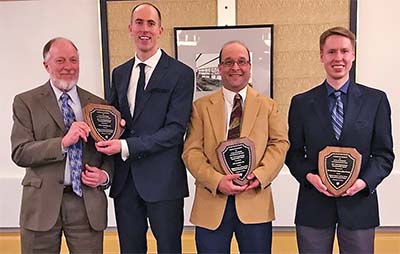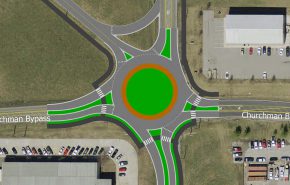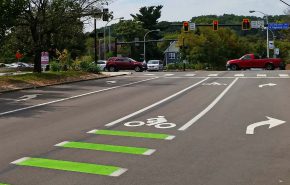Several traffic engineering best practices came together to improve safety and mobility at a bustling Pittsburgh, PA intersection. Guest blogger GAI Engineering Director Richard Krajcovic Jr., PE, PTOE, MBA describes the award-wining outcome.
GAI Consultants has won the American Society of Civil Engineers (ASCE) Pittsburgh Section’s 2017 Sustainability Award for its work toward providing safer transit for pedestrians, cyclists, and motorists by redesigning the intersection of Highland Avenue and East Liberty Boulevard for client the Urban Redevelopment Authority (URA) of Pittsburgh.

My last article, 5 Traffic Engineering Strategies for Safer Urban Intersections, discussed several modern solutions that improve both traffic flow and safety for the users of old, outmoded city intersections—benefiting pedestrians, drivers, and cyclists alike. A recent GAI project for the Urban Redevelopment Authority of Pittsburgh, Pennsylvania put several of these methods to work to boost safety and mobility for the diverse users of the high-traffic intersection of the City’s East Liberty Boulevard and Highland Avenue.
An Old Intersection That Needed New Ideas
Last reconfigured in the late 1960s, this multi-lane, four-way intersection represented a sort of ‘perfect storm’ of diverse street users. The intersection is busy with cars, trucks, pedestrians, and cyclists, and the northwest corner of the intersection is home to the Barack Obama Academy of International Studies—a public school with an enrollment of nearly 900 students grades 6-12.
Focusing on Pedestrian Safety
The safety of Obama Academy students was a key driver. We installed a series of flashing school-zone signals to alert and slow vehicle traffic during pick-up and drop-off hours, and worked to narrow street crossing distances to allow ample time for students and other pedestrians to get from one side of the street to the other. Before we began the project, there were two asphalt strips opposite the school’s south entrance that ran across the median of East Liberty Boulevard in the middle of the block. This meant that students looking to take a short cut would at times cross in the midst of traffic, with obvious safety implications. We eliminated those strips, and filled the gaps in the median with landscaping in order to channel all pedestrians to the actual corners were we had crossing controls installed. Two non-typical intersection islands were also removed to reduce the number of conflicts and crossing movements at the intersection. Additionally, all pedestrian crossings were redesigned for full Americans with Disabilities Act (ADA) compliance.
![]()
Serving the Needs of Students and Commuters
Existing Pittsburgh Port Authority commuter bus stops were located at the same points as school bus staging areas—which meant that commuters had to walk out into the street to flag down arriving busses. We worked with the Port Authority to relocate the bus stops away from the school bus zones, mitigating the conflict for space and significantly boosting the safety factor for bus riders.
Safely Getting Drivers Where They Need to Go
Inpatient and confused drivers were long a problem at the intersection. Before the redesign, the traffic lights used ‘inductive loop’ sensors in the pavement to help allocate green lights—but these would only detect vehicles when they passed over the loop or when they were sitting directly on top of it. We installed improved traffic-detection technology at the intersections that utilizes radar detectors—these track every vehicle within hundreds of feet of the intersection, and they’re constantly analyzing signal timings and optimizing green light allocations for all the various approaches. Additionally, we vastly improved signage to assign clear and defined functions—left turn, through traffic, right turn—to all approaches of the multi-lane intersection.
![]()
Secure Travel for Cyclists
For cyclists, we improved bike lane signage and markings with bolder, brighter colors that could be easily spotted by motorists. These markings also indicate defined points where vehicles could cross bike lanes in order to execute turns—increasing the mutual awareness of cyclists and drivers alike.
![]()
By law, bikes are required to travel with the flow of traffic within the bike lane, which is located at the far right edge of the street. This naturally causes safety issues when bikes need to turn left, a maneuver that takes them across the motor vehicle lanes. To address this safety issue, we implemented two-stage left-turn boxes—these split left turns for bikes into two separate maneuvers, and while it may be a longer process for the cyclist, the boxes serve to make cyclists more visible, keep them out of the path of cross traffic, and better position them for safe passage.
Modern Traffic Engineering Methods = The Intersection of Safety and Mobility
A variety of users now share the busy intersection of Highland Avenue and East Liberty Boulevard with increased safety and mobility. Drivers enjoy smoother traffic flow, pedestrians enjoy easier crossing, cyclists benefit from ample designated lanes, and commuters can access busses without risk to their personal safety. Modern traffic engineering techniques have come together to help make this busy intersection in Pittsburgh a prime example of enhanced public space, and a model for urban street design.
Contact GAI Engineering Director Richard Krajcovic Jr., PE, PTOE, MBA, 412.399.5186, for more information about GAI’s transportation and traffic engineering services.
![]() Richard Krajcovic Jr., PE, PTOE, MBA specializes in transportation and traffic engineering analysis and design. Rich has 16 years of transportation experience with public and private projects, including agency coordination, bicycle and pedestrian accommodations, public involvement, highway occupancy permits, temporary traffic control design (maintenance and protection of traffic), traffic signal and interconnected traffic signal system design, transportation impact studies, transit oriented development planning, signing and pavement marking design, alternatives analysis and development, and data collection and analysis.
Richard Krajcovic Jr., PE, PTOE, MBA specializes in transportation and traffic engineering analysis and design. Rich has 16 years of transportation experience with public and private projects, including agency coordination, bicycle and pedestrian accommodations, public involvement, highway occupancy permits, temporary traffic control design (maintenance and protection of traffic), traffic signal and interconnected traffic signal system design, transportation impact studies, transit oriented development planning, signing and pavement marking design, alternatives analysis and development, and data collection and analysis.


